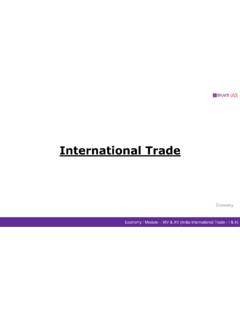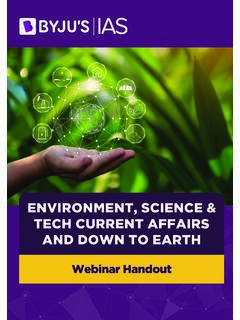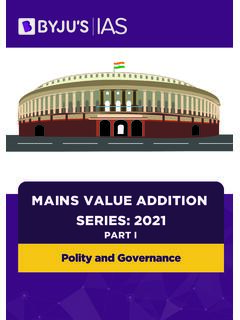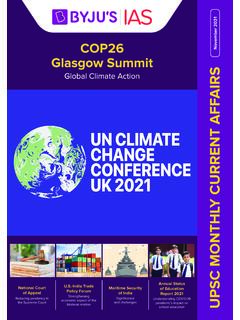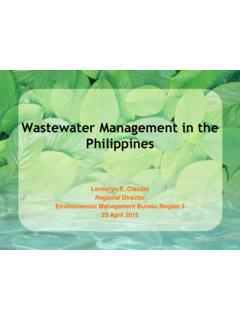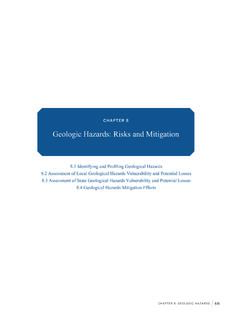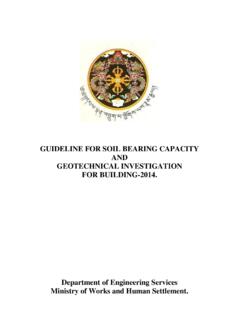Transcription of BYJU’S IAS MAINS TEST SERIES
1 BYJU S IASMAINS TEST SERIES 2021` Main Test SERIES (MTS-GS3-09) 1 TECHNOLOGY, BIO-DIVERSITY, ENVIRONMENT, AND SECURITY (MTS-GS3-09) EXPLANATION 1. In India, there is a need for a shift from the traditional species-focused conservation model towards the ecosystem restoration model . Elucidate. (10 Marks, 150 Words) Approach: Introduction: Briefly explain the Traditional Species Focused Conservation Model and compare it with the Ecosystem Restoration Model. Body: Give a brief background on Ecosystem Restoration Why India should shift to Ecosystem Restoration Model How can Ecosystems in India be restored? Conclusion: Briefly sum up the answer by stressing upon the need to progressively shift towards the ER model while also improving the species centric model.
2 Introduction: The traditional species focused conservation model is aimed at protecting a particular species through relevant policy formulation and field-level activities. The programmes under this model of conservation focus on threats to the species and the issues surrounding these threats. Prominent among these are poaching, human-wildlife conflict, trade in wildlife, habitat destruction and legal support. Ecosystem restoration, on the other hand, is a process of reversing the degradation of ecosystems to regain their ecological functionality . In other words, to improve the productivity of ecosystems to meet the needs of society.
3 This can be done by allowing the natural regeneration of overexploited ecosystems. Body: The traditional species focussed method is often restricted to the bottom up approach of increasing the number of species in an ecosystem through different standalone interventions. This often tends to ignore the role of other parts of the ecosystem and potential of different stakeholders. Need to Shift Towards Ecosystem Restoration Model: It is based on a comprehensive strategy that has taken into account degradation of different ecosystems at a district, state and national levels. It helps to direct policy-making, project identification, resourcing and implementation towards these pre-set priorities.
4 Projects that can deliver benefits across more than one priority may receive more attention. One such example of ecosystem restoration is water security, which requires attention to our catchment areas, freshwater lakes, rivers, etc. It focuses on the improvement of the overall biodiversity. For example, many of our forests have lost much of their native plants due to invasion by alien species. As a result, they are legally protected, but ecologically unprotected. This gap is met through ecosystem restoration. Another important function of the ER is disaster management. An integrated approach of managing the environment inherently adds resilience to the environment.
5 Integrated wetland management, for example, results in making the urban areas more self-sufficient in water availability as well as helps turn the cities into sponge cities in case of extreme events like urban floods or cloudbursts. ` Main Test SERIES (MTS-GS3-09) 2 A policy based on the ER model strikes a balance between the needs of climate change, ecosystem integrity and biodiversity conservation. It also includes aspects like goal setting, leveraging diverse streams of knowledge, monitoring, financing, public-private partnership etc. The ER model also puts at the centre the significance of the local and traditional knowledge of the local community in preserving the ecosystem in an organic and sustainable manner.
6 Developing low-cost, replicable restoration models will enable restoring larger areas with the same funding. Integrating various restoration projects within a landscape could help obtain greater synergies and scale. One such example is the concept of sacred groves in India. The shift towards Ecosystem Restoration requires the following: Building Capacity: Capacity needs to be developed to tailor the best practices of ecosystem Restoration to the Indian situation and also inculcate this as part of the specialised discipline dealing with restoration of plants, geology, hydrology etc. Forest Departments are the key stakeholders in this.
7 Scaling up: Most of the ecosystem installation is done at the local community level. This can be scaled further with the help of state s intervention and awareness by civil society. Research: Restoration research needs to focus on finding adaptable solutions to field challenges. Leading institutions like IITs and IISc need to focus their environmental engineering studies on ecological restoration. Investment: Funding agencies, including corporate CSR, need to assign larger resources for this important activity. Participation: For the ecosystem restoration model to work successfully, it is necessary to ensure the involvement of all the stakeholders.
8 Many countries have public-private partnership models for restoration where authorized organisations participate in the process, both on nonprofit and for-profit models. Conclusion: The shift towards the ER model needs to be in a phased and progressive manner. While trying with the ER model wherever feasible, efforts also need to be made to improve the species-centric model by taking the entire ecosystem of the species (especially the keystone species) into consideration. ` Main Test SERIES (MTS-GS3-09) 3 2. Increasing human-wildlife conflict in India is a result of surging environmental destruction and rising intolerance against the wildlife.
9 Elaborate the given statement along with the measures taken by the government to ameliorate the situation. (10 Marks, 150 Words) Approach: Introduction: Define human-wildlife conflict and provide key statistics regarding the same, showing the trend. Body: Explain the causes for increasing conflicts. Cite examples supporting your reasons. Mention the measures taken by the government to solve the issue. Suggest suitable long term measures for the same. Conclusion: Conclude by emphasising the values of non-violence and tolerance and the principle of live and let live . Answer: Introduction: Human-wildlife conflict refers to the negative interaction between the humans and wildlife species resulting in loss of property, livelihoods, and even life.
10 The report titled - A Future for All - A need for human wildlife coexistence was recently released by the World Wildlife Fund for Nature and UNEP. As per the report Human Wildlife conflict related killing affects more than 75% of world s cat species as well as many other terrestrial and marine carnivore species. Body: The frequency of such conflicts has only increased in recent times. The underlying causes behind this increase are: Surging environmental destruction: Habitat Degradation and fragmentation: Human activities have resulted into fragmentation of habitat by the construction activities for highways, railways etc.

